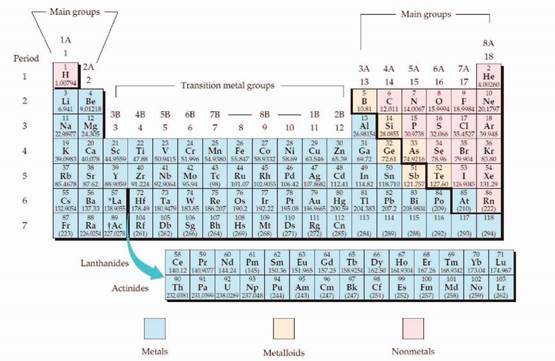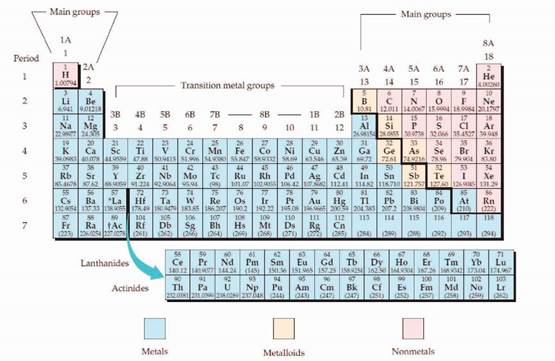
(a)
Interpretation:
The location and categories of Krypton element should be identified.
Concept introduction:
The periodic table is given below,

Figure 1
Noble gases:
The six noble gases are Helium (
(b)
Interpretation:
The location and categories of Strontium element should be identified.
Concept Introduction:
The periodic table is given below,

Figure 1
(c)
Interpretation:
The location and categories of nitrogen element should be identified.
Concept introduction:
The periodic table is given below,

Figure 1
(d)
Interpretation:
The location and categories of cobalt element should be identified.
Concept introduction:
The periodic table is given below,

Figure 1
Want to see the full answer?
Check out a sample textbook solution
Chapter 2 Solutions
Fundamentals of General, Organic, and Biological Chemistry (8th Edition)
- Arrange the elements Na, Si, and S in the order of(a) decreasing atomic radius.(h)increasing first ionization energy.arrow_forwardThe atomic mass of an element can be used to determine A) the chemical properties of the element B) the number of protons in the element C) the number of neutrons in the element D) the number of protons plus neutrons in the element E) both the number of protons and the chemical properties of the elementarrow_forwardOxygen has 8 protons, 8 neutrons, and 8 electrons. What is its atomic mass?(a) 8 (b) 16 (c) 24 (d) 32.arrow_forward
- The atomic mass number of an atom is determined by the sum of the number of in the atom. (a) protons plus electrons plus neutrons (b) protons plus electrons (c) neutrons plus electrons (d) neutrons plus protonsarrow_forwarda) Identify the following as element (atomic or molecular), compound or mixture. b) Explain your reasoning and draw a sample of these substances containing 5 particles of that particular material. c) What would be the mass of 5 particles of that particular material? Show your work! H20 N2 C2HSOH Iodine gasarrow_forward1.1. An atom of element X has an atomic number of 14 and a mass number of 30. Which of the following statements is correct? (A) An atom of sodium has 14 protons, 14 electrons, and 14 neutrons.(B) An atom of sodium has 14 protons, 16 electrons, and 14 neutrons(C) An atom of sodium has 14 protons, 14 electrons, and 16 neutrons.(D) An atom of sodium has 14 protons, 16 electrons, and 16 neutrons.1.2. The ability of carbon to form four covalent bonds with a variety of atoms is(A) Isomerism(B) Tetravalence(C) Hydrolysis(D) Quadravalence1.3. Water resists changing its temperature because of its … (A) High heat of vaporization(B) Low specific heat(C) High specific heat(D) Low heat of vaporization1.4. A solution where [H+] < [OH−] is more:(A) Acidic(B) Basic(C) Neutral(D) None of the above1.5. Malnourishment results when there is(A) A diet that does not provide enough fatty acids(B) A diet with short-term absence of one or more essential nutrients(C) A diet that does not provide enough…arrow_forward
- Calculate the coulomb energy for the following three nuclei using the semi-empirical mass formula. a) 19F b) 48Tİ c) 63Cuarrow_forwardLook up the valence electron configuration, covalent atomic radius, effective nuclear charge, first ionization energy and Pauling electronegativity in Chapter 8 (tables are attached). Examine the above data and answer the following questions. a) Explain why some of the elements like TI and Pb on the lower left of the p block are metallic. b) Explain why some of the elements like C, Si in the center of the p block form covalent bonds. Explain why these bonds formed by the network of these elements (as studied in Chapter 25) tend to be unreactive. c) Explain why the noble Group 8A elements are highly unreactive gases. d) Explain why some elements like F, CI, Br etc, on the upper right of the p block are highly reactive nonmetals.arrow_forward(I) Why the physicochemical changes in liquid water caused by radiation is the key to understanding the biological effects of radiation? Please give a short, one-sentence explanation. (II) Name the three key stages of the physicochemical changes produced in liquid water due to radiation. (III) Briefly describe the three key stages. A one- or two-sentence explanation for each of the three key stages would be sufficient.arrow_forward
- . Give the name of and symbol for an element with this number of valence electrons.a) 2b) 6c) 8arrow_forwardAssume that you list the following types of electromagnetic radiation in order of increasing wavelength: () the gamma rays produced by a radioactive nuclide used in medical imaging: (ii) radiation from an FM radio station at 93.1 MHz on the dial; (iii) a radio signal from an AM radio station at 680 kHz on the dial; (iv) the yellow light from sodium vapor streetlights; (v) the red light of a light-emitting diode. Which one would be the second? Lütfen birini seçin: O a 680 kHz AM radio waves O b. the red light O c the yellow light O d. 93.1 MHz FM radio waves O e the gamma raysarrow_forwardArrange in order of increasing nonmetallic character (a) the period 3 elements Na, Cl, & Mg (b) the Group 7A elements At, F, & Iarrow_forward
 BiochemistryBiochemistryISBN:9781319114671Author:Lubert Stryer, Jeremy M. Berg, John L. Tymoczko, Gregory J. Gatto Jr.Publisher:W. H. Freeman
BiochemistryBiochemistryISBN:9781319114671Author:Lubert Stryer, Jeremy M. Berg, John L. Tymoczko, Gregory J. Gatto Jr.Publisher:W. H. Freeman Lehninger Principles of BiochemistryBiochemistryISBN:9781464126116Author:David L. Nelson, Michael M. CoxPublisher:W. H. Freeman
Lehninger Principles of BiochemistryBiochemistryISBN:9781464126116Author:David L. Nelson, Michael M. CoxPublisher:W. H. Freeman Fundamentals of Biochemistry: Life at the Molecul...BiochemistryISBN:9781118918401Author:Donald Voet, Judith G. Voet, Charlotte W. PrattPublisher:WILEY
Fundamentals of Biochemistry: Life at the Molecul...BiochemistryISBN:9781118918401Author:Donald Voet, Judith G. Voet, Charlotte W. PrattPublisher:WILEY BiochemistryBiochemistryISBN:9781305961135Author:Mary K. Campbell, Shawn O. Farrell, Owen M. McDougalPublisher:Cengage Learning
BiochemistryBiochemistryISBN:9781305961135Author:Mary K. Campbell, Shawn O. Farrell, Owen M. McDougalPublisher:Cengage Learning BiochemistryBiochemistryISBN:9781305577206Author:Reginald H. Garrett, Charles M. GrishamPublisher:Cengage Learning
BiochemistryBiochemistryISBN:9781305577206Author:Reginald H. Garrett, Charles M. GrishamPublisher:Cengage Learning Fundamentals of General, Organic, and Biological ...BiochemistryISBN:9780134015187Author:John E. McMurry, David S. Ballantine, Carl A. Hoeger, Virginia E. PetersonPublisher:PEARSON
Fundamentals of General, Organic, and Biological ...BiochemistryISBN:9780134015187Author:John E. McMurry, David S. Ballantine, Carl A. Hoeger, Virginia E. PetersonPublisher:PEARSON





